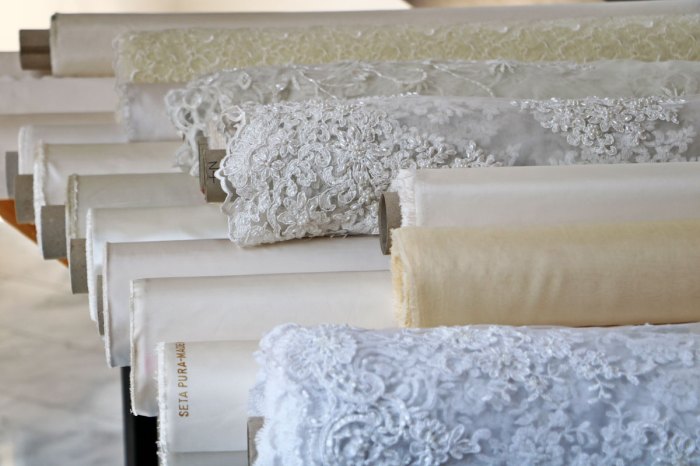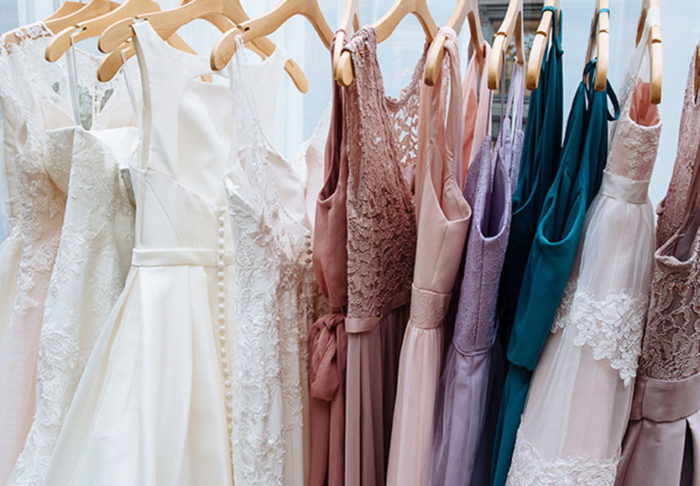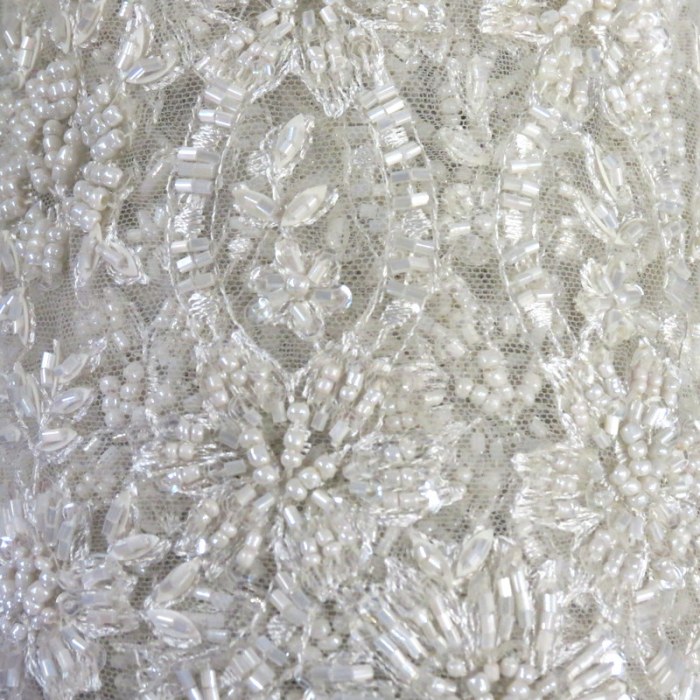Popular Fabric Choices for Wedding Dresses
Fabric types for wedding dresses – Choosing the right fabric for your wedding dress is crucial, as it significantly impacts the overall look, feel, and comfort of the gown. The drape, texture, weight, and sheen of the fabric will determine the silhouette and aesthetic of the dress. This section explores some of the most popular fabric choices, highlighting their characteristics and suitability for different styles.
Characteristics and Suitability of Popular Wedding Dress Fabrics
Several fabrics stand out as perennial favorites for wedding gowns, each offering unique qualities.
| Fabric Type | Characteristics | Suitable Dress Styles | Examples of Aesthetics |
|---|---|---|---|
| Satin | Smooth, lustrous sheen; heavy to medium weight; excellent drape; can be slippery | A-line, mermaid, sheath | Classic elegance, modern glamour; a sleek, sophisticated look; can create a dramatic silhouette. A satin ballgown might feature a fitted bodice and a full, flowing skirt. |
| Silk | Luxurious, soft texture; lightweight to medium weight; excellent drape; subtle sheen | A-line, ballgown, empire waist | Romantic, ethereal; flowing, graceful silhouette; can be embellished with lace or beading for added detail. A silk charmeuse gown might have a soft, flowing silhouette. |
| Lace | Delicate, intricate patterns; lightweight to medium weight; varies in drape depending on the type of lace; can be sheer or opaque | A-line, ballgown, sheath | Romantic, vintage, bohemian; delicate and feminine; can be layered over other fabrics for added texture. A lace overlay on a satin dress creates a luxurious and romantic look. |
| Tulle | Lightweight, sheer; stiff texture; excellent for creating volume; little to no drape | Ballgown, princess | Romantic, whimsical; creates a full, fluffy skirt; often used for overlays or underskirts. A tulle ballgown can be very dramatic and voluminous. |
| Organza | Lightweight, sheer; crisp texture; holds its shape well; minimal drape | A-line, ballgown | Romantic, delicate; creates a structured, yet airy look; often used for overlays or embellishments. An organza overlay on a simpler dress adds a layer of texture and visual interest. |
Less Common but Luxurious Fabric Options
Beyond the traditional choices, several less common fabrics offer a unique touch of luxury and sophistication to a wedding dress. These options often come with a higher price tag but provide unparalleled elegance and distinctiveness.
Properties and Suitability of Luxurious Fabrics
These fabrics offer a different aesthetic and feel compared to more common choices.
Crepe: Known for its slightly pebbled texture, crepe offers a matte finish and excellent drape, creating a sophisticated and modern look. It’s suitable for various dress styles, from sleek sheath gowns to flowing A-lines. A crepe wedding dress might feature clean lines and a minimalist aesthetic.
Charmeuse: A luxurious silk fabric with a smooth, lustrous surface and exceptional drape. Its subtle sheen and fluid movement create a glamorous and elegant look, ideal for more fitted silhouettes. A charmeuse gown might exude a sense of old-Hollywood glamour.
Mikado: A heavy, crisp silk fabric with a slight sheen. It holds its shape beautifully, creating a structured and regal silhouette. Mikado is perfect for more formal styles like ballgowns and structured A-lines. A Mikado wedding dress often conveys a sense of strength and sophistication.
Brocade: A richly textured fabric with intricate woven patterns. Brocade adds a touch of opulence and historical elegance to a wedding dress. Its weight and structure make it suitable for structured silhouettes. A brocade wedding dress can be dramatic and eye-catching.
Generally, these luxurious fabrics are more expensive than satin, silk, lace, tulle, and organza.
Fabric Considerations Based on Season and Climate
The season and climate of your wedding significantly impact the comfort and practicality of your chosen fabric. Selecting appropriate materials ensures you stay comfortable and confident throughout your special day.
Fabric Choices for Different Seasons
- Summer Weddings: Lightweight and breathable fabrics like cotton, silk chiffon, linen, and organza are ideal for hot weather. These fabrics allow for better air circulation, keeping you cool and comfortable.
- Winter Weddings: Fabrics like velvet, brocade, silk taffeta, and heavier lace offer warmth and luxury for colder climates. These fabrics provide insulation and a sense of opulence, perfect for a winter wonderland wedding.
Impact of Fabric on Wedding Dress Silhouette and Design: Fabric Types For Wedding Dresses
The choice of fabric profoundly influences the overall silhouette and design of a wedding dress. The drape, structure, and weight of the fabric directly impact how the dress falls and shapes the bride’s figure.
Fabric’s Influence on Silhouette and Design

Source: newtess.com
A flowing silk chiffon creates a romantic, ethereal silhouette, while a structured Mikado silk produces a more regal and formal look. The fabric’s weight and drape also affect the neckline, sleeves, and embellishments. Lightweight fabrics are better suited for delicate embellishments, while heavier fabrics can support more elaborate designs. The fabric’s texture and drape influence the ease of movement and overall comfort.
A heavier fabric might restrict movement compared to a lighter one.
Example 1 (Silk Chiffon): Imagine a flowing A-line gown, the silk chiffon cascading gracefully from the shoulders, creating a soft, romantic silhouette. Delicate lace appliqués adorn the bodice, adding a touch of whimsy.
Example 2 (Mikado Silk): Picture a structured ballgown, the Mikado silk holding its shape beautifully, creating a regal and sophisticated silhouette. The bodice is fitted, accentuating the waist, while the skirt is full and voluminous.
Example 3 (Lace): Envision a fitted sheath dress, the lace intricately woven, creating a delicate and feminine look. The lace’s texture adds visual interest, while the fitted silhouette accentuates the bride’s figure.
Fabric Care and Maintenance for Wedding Dresses

Source: amazonaws.com
Proper care and maintenance are crucial for preserving your wedding dress for years to come. Understanding the specific needs of your dress fabric ensures its longevity and allows you to cherish it as a treasured keepsake.
Care and Preservation of Wedding Dress Fabrics, Fabric types for wedding dresses

Source: discountfabrics-sf.com
- Professional Cleaning: Delicate fabrics like silk, lace, and organza should always be professionally dry-cleaned to avoid damage.
- Storage: Store your dress in a breathable garment bag in a cool, dry place away from direct sunlight and moisture.
- Spot Cleaning: For minor stains, gently blot with a clean, damp cloth. Avoid rubbing, which can spread the stain.
- Avoid Harsh Chemicals: Never use bleach or harsh detergents on your wedding dress.
Q&A
Can I wear a silk wedding dress in the summer?
Choosing the right fabric is crucial for a wedding dress, impacting both comfort and aesthetic. The drape and structure of the material significantly influence the overall look; for instance, the choice dramatically changes the effect on styles like elegant mermaid wedding dresses. Ultimately, the selection of fabric, whether it’s lace, satin, or tulle, significantly contributes to the final impression of the gown.
While silk is luxurious, heavier silk fabrics might be too warm for a summer wedding. Consider lighter silk options or other breathable fabrics.
How much should I expect to pay for a wedding dress made from a specific fabric?
Fabric cost varies greatly. Silk and lace tend to be more expensive than tulle or organza. The overall price depends on fabric quality, embellishments, and designer.
What fabrics are best for plus-size wedding dresses?
Supportive fabrics like Mikado or crepe can create a flattering silhouette for plus-size figures. Avoid fabrics that cling too much.
How do I care for my wedding dress after the wedding?
Professional cleaning is highly recommended, especially for delicate fabrics. Follow the care instructions provided by the designer or dry cleaner.
